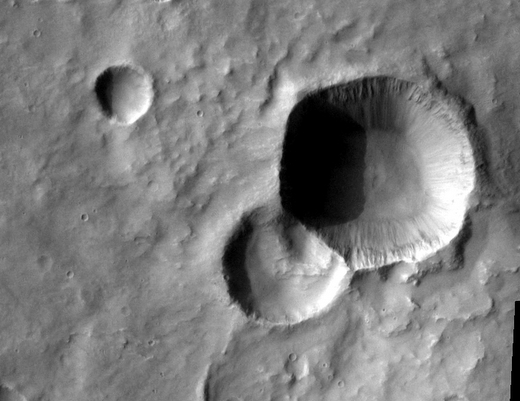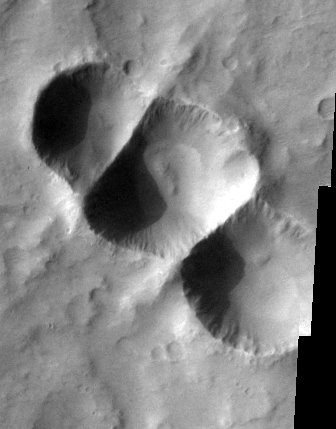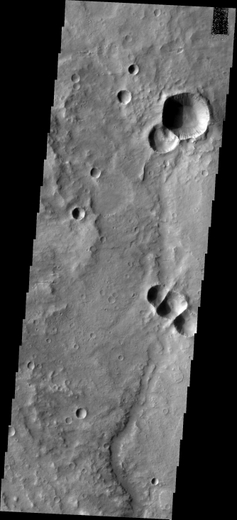Scientists working with the Mars Odyssey spacecraft say that it’s not uncommon for multiple pieces of a meteor to impact Mars close together at the same time. Here, a triple crater was formed simultaneously when three pieces of a meteor struck Mars’ surface together. When this happens, the craters that are formed overlap and the force of the impacts results in a linear wall separating the craters that form side-by-side. This image is part of a larger image swath taken by the THEMIS instrument (Thermal Emission Imaging System) on the Odyssey spacecraft. On another part of this larger image, there’s also a double crater.

This double crater appears to be different, however, from the triple crater in that the two craters were likely formed at different times. The smaller crater to the left appears older, since material from when the second, larger crater to the right was formed has been thrown into the crater on the left. The crater on the left appears more eroded and weathered, as well.
Here’s the entire image swath from Odyssey:
The Mars Odyssey spacecraft arrived at Mars on October 24, 2001, and has been mapping the surface of the Red Planet since February 2002.
Click here to see a map of Mars where these craters are located.
Original News Source: THEMIS/Mars Odyssey webpage



would shoemaker levy 9 have created such an impact if it hit mars
The triple craters depth seems to be equal in all three dents, where the large part of the double crater is a deeper level, so they were separate impacts right? If so, how would the wall between the two remain so “Crisp” in appearance?
To LLDiaz’ question:
Shoemaker Levy-9 comet fragments were all of very different masses and diameters, so it would have produced many separate and different sizes and shapes of craters. I remember something around 22 different impacts on Jupiter over an extended period of time, which would probably produce a much different pattern / event.
The triple crater above looks like all three pieces hit at the same time and speed, which would have to be VERY rare.
Not all Shoemaker-Levy 9 could have hit Mars, since Mars is a much smaller target. However fragment G of SL-9 was about 2 miles across. If that sucker would’ve hit Mars, I bet it would have created another hole, maybe not the size of Hellas Basin, but big enough to see in a medium sized telescope.
Cool article. It beats the hell out of Dark Matter, Global Warming and “What If” stories.
I have indeed problems “seeing” the mechanism that builds the “crisp” walls.
Had to checkc the date to see if not an April Fool. I’m more than a bit ignorant about these things.
Cool photo